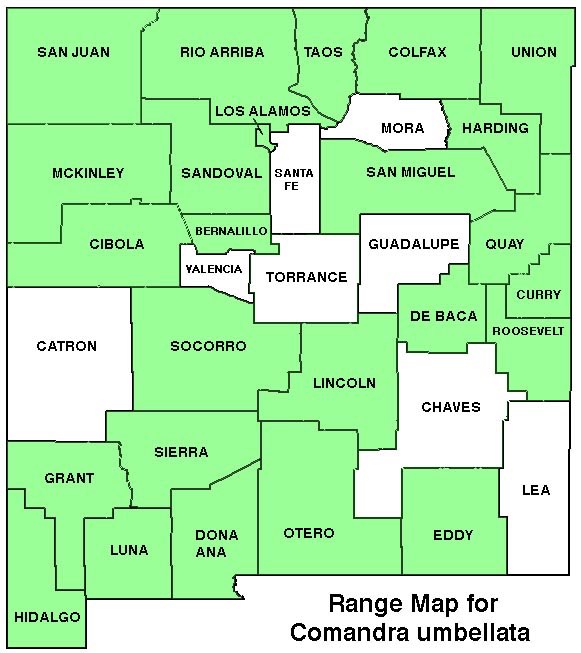WILDFLOWERS OF NEW MEXICO

With stems to 1–foot-tall and spreading rhizomes, this leafy plant can form dense colonies in meadows, open woodlands, and roadsides. Though it has green leaves, it parasitizes the roots of more than 200 plant species, making it the most widespread and diverse parasitic plant in North America. Note the dense, rounded clusters of small, star-shaped, white to greenish-white or pink flowers.
FLOWER: May–July. Rounded clusters with 3–6 white to greenish-white or pinkish flowers above a leaf-like bract; 5 petal lobes 1/8–1/4-inch across (3-7 mm).
LEAVES: Alternate, thick, whitish-gray-green (glaucous). Blade narrow, linear to lance-shaped or oblong, 1/4–1 1/2-inches long (5-40 mm), to 3/8-inch wide (10 mm); margins entire, tip acute.
HABITAT: Dry sandy, clay soils, open woodlands, meadows, roadsides, disturbed areas; pinyon-juniper woodlands.
ELEVATION: 2,100–8,200 feet.
RANGE: Every state except Gulf coast.
SIMILAR SPECIES: The rounded cluster of creamy, 5-lobed flowers, and the thick leaves help distinguish this species.
NM COUNTIES: Widespread in NM in low- to mid-elevation dry habitats: Bernalillo, Cibola, Colfax, Curry, De Baca, Dona Ana, Eddy, Grant, Harding, Hidalgo, Lincoln, Los Alamos, Luna, McKinley, Otero, Quay, Rio Arriba, Roosevelt, San Juan, San Miguel, Sandoval, Sierra, Socorro, Taos, Union.

BASTARD TOADFLAX
COMANDRA UMBELLATA
Sandalwood Family, Santalaceae
Perennial herb, hemiparasitic

THE CONTENTS OF THIS WEBSITE ARE COPYRIGHTED AND CANNOT BE USED
WITHOUT PERMISSION OF GEORGE OXFORD MILLER


EMAIL ME